Recent Water Damage Posts
How Do I Replace A Toilet?
11/1/2022 (Permalink)
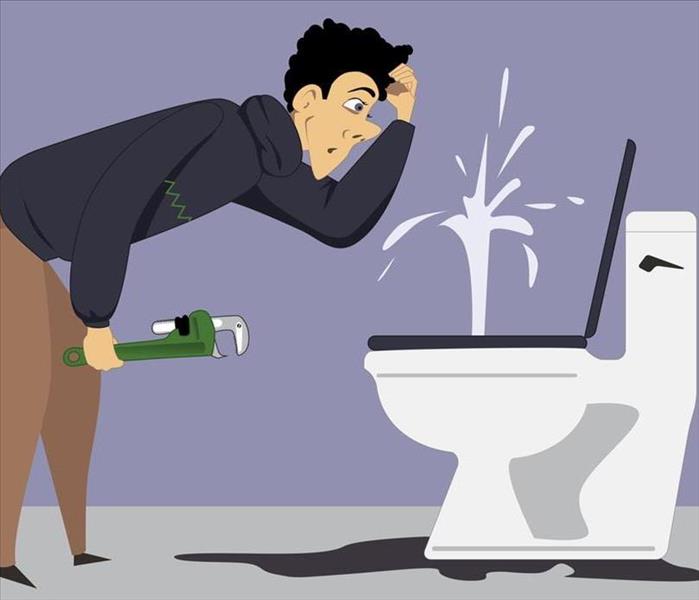 If you think your toilet is leaking or not working as well as it should, replace it.
If you think your toilet is leaking or not working as well as it should, replace it.
How Do I Replace A Toilet?
Replacing a toilet can seem like an overwhelming task, but it's not. The average DIYer can typically complete this project in about six hours. Here are the step-by-step instructions for replacing a toilet:
Cut the water supply, flush toilet, and sponge all remaining water from tank and bowl.
- Cut the water supply to the toilet, then flush it to drain any remaining water.
- If you have a frost-free refrigerator or freezer, turn off its power switch and remove all food from inside (this will help prevent damage).
- Unscrew any mounting bolts that are holding the hot water tank in place and lift it out of its housing; don't worry if some piping comes with it because you can reattach these later.
Disconnect hose leading to bottom of tank.
Now that the tank is out of the bowl, you can disconnect the hose leading to the bottom of the tank. You may have to loosen or unscrew a clamp holding it in place before pulling it free. The water supply should now be disconnected from your toilet.
To lift out your old toilet, shift your weight slightly toward one side and lift it straight up until you can set it aside.
Unscrew the nuts that connect the tank to the bowl, remove tank and set aside.
- Unscrew the nuts that connect the tank to the bowl, remove tank and set aside
- Remove any remaining water from inside the toilet bowl with a sponge or towel
- Remove old wax ring from underneath where you will replace it (usually a square piece of plastic).
Remove nuts that hold bowl to floor, lift straight up on bowl and set aside.
To replace the toilet, you'll need to remove the nuts and washers that hold the bowl to its base. To do this:
- Remove the nuts on each side of your toilet using socket set or wrench.
- Lift straight up on the bowl and set it aside.
Remove any wax ring or putty that remain around drain collar on floor.
- Remove any wax ring or putty that remain around drain collar on floor.
- Use a putty knife to scrape off any old putty, if there is any.
- Clean the area around the drain collar with a sponge and mild detergent, then use dry paper towels to dry it thoroughly.
Install new wax ring onto new toilet base.
- Place the new toilet base on wax ring.
- Press down firmly so that it adheres to the wax ring (no rocking). Ensure a tight connection between toilet base and wax ring. If you have a leak, tighten the connection between the toilet base and wax ring by adding more plumber's putty or tightening with adjustable wrench as needed.
Set new toilet in place and press down firmly so that it adheres to the wax ring (no rocking).
Once the new toilet is in place, you must press down firmly to ensure that it is properly seated on the floor. If you see any rocking motion, then there may be an issue with the wax ring, and you should check for leaks before proceeding further.
If no leaks are present and your toilet is not leaking after pressing down firmly on it, then proceed to connect water supply lines and test operation of the new toilet.
Reattach the new and old water line, ensuring a tight connection.
To reattach the new and old water line, ensure that the water supply is turned off. Then, make sure that your new toilet is level with your old one and secure. The last thing you want is for it to start shifting around on you during installation. If need be, use a wrench to tighten the bolts so they're nice and tight.
Replace your toilet if you think it is leaking or not working well — but if leaks persist call a professional plumber
If you think your toilet is leaking or not working as well as it should, replace it. But if you are not sure and want to check if there is a leak, first check the water level in your tank. If the water level is lower than normal, check for leaks at the base of the toilet by submerging a towel under it and checking on both sides; look for wet spots under the tank lid and base.
If you think there may be a leak but are unsure how to fix it yourself (or hire someone to do so), here's how to replace a toilet:
- Turn off the power source or flush handle/valve assembly that serves as an access point for stopping wastewater flow from pipes leading from your home’s plumbing system
- Unscrew bolts holding down flange between bowl unit and floor with socket wrench; remove flange from bowl unit
You can replace your toilet and save money. The first step is to turn off the water supply, disconnect the old tank and bowl, remove the old wax ring, and set aside. Then, install a new wax ring onto the base of your new toilet (not into floor). Finally, set it in place and press down firmly so that it adheres to the wax ring (no rocking). Reattach old water line to new toilet base ensuring a tight connection before turning on water supply once again!
National Flood Insurance Program
5/16/2022 (Permalink)
The National Flood Insurance Program policy covers direct physical losses to your belongings and structures after a flood event. The NFIP has two types of coverage: your home itself and your belongings. Here are some examples of what IS covered by your flood insurance policy:
Building Coverage
- Electrical and Plumbing Systems
- Water heater and furnaces
- Refrigerators, stoves, ovens, built-in appliances like dishwashers
- Permanently installed fixtures, such as carpeting, cabinets, paneling, and bookcases
- Window blinds
- Foundation walls, anchorage systems, and staircases
- Detached garages
- Fuel tanks, pumps and well water tanks, and solar energy equipment
Content Coverage
- Personal belongings like clothing, furniture, and electronic equipment
- Curtains
- Washer and Dryer
- Portable and window air conditioners
- Microwave oven
- Carpets not included in building coverage like carpet installed over wood floors.
- Valuable items like original artwork and furs (up to $2,500)
What isn’t covered by flood insurance?
Flood insurance is determined by the cause of flooding and only covers damages directly caused by the flooding. For example, losses caused by a sewer backup is covered if the backup is a direct result of flooding. Here are some examples of things not covered by insurance:
- Temporary housing and additional living expenses while the building being repaired is unable to be occupied
- Property outside of the insured building like wells, landscaping, decks and patios, fences, swimming pools, etc.
- Financial losses caused by business interruption
- Currency, precious metals, stock certificates and other valuable papers
- Cars and most self-propelled vehicles, including their parts
- Personal property kept in basements
For more information about your coverage talk to your insurance agent before hurricane season starts, and visit FloodSmart | What Does Flood Insurance Cover?
Preventing Water Damage to Foundations
5/9/2022 (Permalink)
The most efficient way to prevent and/or fix a problem is to hire a structural engineer to help, as there can be a wide range of solutions they can provide. However, there are some measures you can take on our own to prevent water damage to the structure’s foundation.
Checking the length of Downspouts
A downspout is a pipe that helps direct rainwater off your roof and away from the building. These need to be as far from your home’s foundation as possible. Without the correct length, the downspout’s purpose is essentially defeated.
Have an Outward- Sloping Landscape
The landscape of your home is very important. Ideally, the ground your home is built on should slope downward to prevent collection of water around your home.
Gutter Cleanup
Gutters around your home need to be free of debris so they should be cleaned as often as possible to prevent clogging.
For more information, visit House Foundation Water Damage: Signs, Causes & Prevention Guide (safeandsanitaryhomes.org)
Causes of Water Damage
5/9/2022 (Permalink)
There can be multiple causes of water damage to a home’s foundation. Water damage can result due to one or more of these likely causes:
- Underground & surface water
- Trees to close to the building
- Poor drainage
- Unstable soil
Underground Water
There are 2 types of underground water: natural occurring and plumbing installations. Natural occurring water includes springs close to or beneath the home. The presence of underground springs may be caused by proximity of pods or other bodies of water. Artificial underground water alternately is created from plumbing installations that pass below a home. Leaks from installations may also affect your home’s foundation.
Surface Water
Surface water combined with the improper evaluation of the landscape causes damage from rain. Rain fall is expected to be directed away from the home by an outward slope of the landscape, but when a home is not graded correctly, it is likely to have pools of water form in your yard. Surface water can also collect around the home and can result in absorption through the foundation.
Tree Proximity
Trees are usually desirable to have around homes because of the benefits they produce but can turn out to be a hassle when they are too close to the structure. The roots of a tree extend outward to try and find water and nutrients. This can affect underground installations like sewer lines, plumbing, and drains. This results in clogging that can contribute to water damage.
Poor Drainage
The roof’s draining system is a vital structure to your home because they guide water down and away from the structure. However, when gutters and downspouts get clogged, water damage is likely to occur.
Unstable Soil
Certain soils are more compact than others and better for building structures on. Loose soil is more likely to cause significant structural problems from cracks and result in water damage because of easy flooding.
Signs of Water Damage
5/2/2022 (Permalink)
Water Damage - Foundation
Many times, homeowners are forced to deal with moisture issues that can weaken a structure's foundation. This moisture can also lead to issues like mold growth, termites, peeling paint, buckled wooden floors, and water stains on walls.
Signs of Water Damage
When there is water damage, the signs aren’t always obvious. They can be subtle or prominent depending on the scale and conditions of the damage. To the untrained eye, the signs aren’t quickly recognized until the problems worsen.
- Cracks in sheetrock
- Caulking disintegrating or pulling away from exterior surfaces surrounding fixtures and tubs
- Presence of ants within or around your home
- Difficulty closing or opening doors
- Cracks in stone or brick fireplace
- Window difficult to close
- Raised or cracked sections of floors
- Ceiling joints may be raised in addition to the possibility of nails pulling out of sheetrock
- Appearance of cracks in brick mortar
For more information visit, House Foundation Water Damage: Signs, Causes & Prevention Guide (safeandsanitaryhomes.org)
Beaumont Residents: We Specialize in Flooded Basement Restoration!
4/25/2022 (Permalink)
A basement can flood at any time, although flooding most often occurs during heavy rainfall. Basements are inherently prone to flooding because they are the lowest level of a building and are normally built partly or entirely below ground level. There are a number of reasons why your [[City or County Name]] basement could flood, including:
- A blocked or failed sewer lateral pipe
- Heavy rain causes surface water to pool around your home
- Storm sewer backup
- Sanitary sewer backup
- Foundation drainage failure
- Water supply-line break or hot-water tank failure
- And many more
Have Questions about Basement Flooding?
Call Today - 409-212-1977
If flood water is not handled quickly and properly, it can jeopardize your health and safety, and cause severe damage to your home’s structure. Remember, the longer you wait, the worse the problem will get.
The bottom line: a flooded basement can jeopardize your health, safety, and your home’s integrity. It’s worth making a call to SERVPRO of [[Franchise Name]] and let our trained, professional crews handle the situation safely and correctly. We have earned the trust of hundreds of homeowners, business owners, and property professionals.
We are Flooded Basement Specialists:
- We are Available 24 hours/7 days per week
- We’re a Preferred Vendor to many National Insurance Companies
- We Bill The Insurance Directly – One Less Thing For You To Worry About
- Our Technicians are Highly-Trained in Water Restoration Techniques
- We use s500 IICRC Restoration Standards
- Advanced Inspection and Extraction Equipment
Basement Flooded? Call Us Today – We’re Ready To Help 409-212-1977
Are You Covered?
4/20/2022 (Permalink)
Water damage can unexpectedly become a problem for anyone at any time. Usually for a variety of reasons, but not an easy fix without the right insurance and help. Water damages usually cannot be solved in the same way, so it is important to know what is covered under homeowners’ insurance.
Two Policies?
Most homeowners’ policies will cover most water damages, but does not include damages made from outside factors, like floods. Most flood-prone areas will not be covered under homeowners’ insurance and will have a separate policy for flood damages specifically. Usually, insurance policies will cover water damage brought on by emergencies such as a burst pipe or a broken HVAC but will not cover things like overflowing gutters that were neglected and not cleaned that directed water into your home. Be sure to check you are covered for floods before the heavy rains, with either your homeowners’ policy or get separate coverage for flood damages before the problems occur. A yearly check-in with your insurance to review policy limits and coverage is recommended as it ensures that you know the full extent of your coverage in case of an emergency.
Call as Soon as Possible
Calling your insurance company as soon as the incident occurs is very important. The longer you let the water damage sit creates a greater percentage of ending up with more problems, like mold. It is crucial that you are prompt in contacting and filing an insurance claim to ensure that you receive the financial support you need.
Preventing Water Damage
5/26/2021 (Permalink)
A small amount of water soaking into your floors, walls or cabinets is all it takes to cause damage in your home or business. A study of closed water damage insurance claims identified plumbing pipes and drain systems as the leading cause of interior water damage. The following tips can help you minimize the risk in your home or business.
- Proper Maintenance — majority of insurance claims were caused by corroded, rusty, or frozen pipes. Maintaining these in your home or business can help prevent any future damage.
- Look for an increase in your monthly water bill—pipes with leaks can cause your water to bill to increase.
- Rust stains, moisture in the walls or on the floor are all potential indicators of plumbing issues.
- If you are on a sewer system or you are located below street level — contact a plumbing professional to install a backflow prevention into your sewer system.
- Make sure to plant trees away from lateral drain lines to prevent roots from damaging pipes.
- NEVER pour grease down the drain.
Source: www.disastersafety.org
Drying & Dehumidification
5/26/2021 (Permalink)
The first step to any water damage is removing the standing water. Even though your floors and walls may look dry at first glance; they are still wet to the touch. Most building materials, like drywall and wood, are porous and will retain significant water. The retained water will cause these materials to warp, swell, or break down and can also cause damage.
SERVPRO of Beaumont & Orange/Nederland/Lumberton will manipulate the temperature and relative humidity to remove the remaining moisture. We use specialized equipment, including industrial air movers and dehumidifiers, to remove water retained by building materials and other hard-to-access moistures. Our SERVPRO professionals carefully monitor the progress using moisture meters until the materials return to acceptable drying goals.
Our SERVPRO of Beaumont & Orange/Nederland/Lumberton professionals are trained and certified according to the Institute of Inspection Cleaning and Restoration Certification (IICRC) guidelines specifically in Water Restoration. SERVPRO also incorporates its own Employee Certification Trainings in Water Damage as well. Our SERVPRO team members are highly trained and ultimately Here to Help!
Determining the Category of Water Damage
5/26/2021 (Permalink)
IICRC S500 Standard Reference Guide for Professional Water Damage Restoration defines three categories of water. Category refers to the type of water affecting the structure.
- A Category I loss is where water originates from a sanitary water source and does not pose substantial risk from dermal, ingestions or inhalation exposure.
- A Category II loss is when water contains a significant contamination and has the potential to cause discomfort or sickness if contacted or consumed by humans. Category II water can contain potentially unsafe levels of microorganisms or nutrients for microorganisms.
- Examples: Discharge from dishwashers or washing machines, overflows from washing machines, overflows from toilet bowls on the room side of the trap with some urine.
- Category III water is grossly contaminated and can contain pathogenic, toxigenic, or other harmful agents and can cause significant adverse reactions to humans if contacted or consumed.
- Examples: Sewage, flood water, and other contaminated water entering or affecting the indoor environment, such as wind-driven rain from hurricanes, tropical storms, or other weather-related events.
Have questions about water damage? Contact the SERVPRO of Beaumont & Orange/Nederland/Lumberton today at (409) 729-2800.
The Professionals!
5/26/2021 (Permalink)
Water damage can happen at any time. SERVPRO of Beaumont & Orange/Nederland/Lumberton handles water damage every day and realizes that prompt action is key in the event of any disaster. Our SERVPRO technicians are trained in the proper techniques to inspect a home or business and assess the damage after a disaster. We use technology that is designed to determine the amount of moisture in an affected area, iPads to document the findings, and the proper placement of air movers and dehumidifiers to ensure proper drying. Our SERVPRO Professionals understand water damage and have the proper training and equipment to take care of all of your water damage needs 24/7, 365 days a year!
Have questions about water damage? Contact SERVPRO of Beaumont & Orange/Nederland/Lumberton today— (409) 729-2800!
When Water Damage Strikes
4/28/2021 (Permalink)
The first 24 hours following a water loss are the most important in preventing secondary or permanent damage. Within four hours of receiving a loss notification, SERVPRO of Beaumont/Orange/Nederland/Lumberton will be on site to help ensure a water damage is handled by completing the following steps.
Inspection
SERVPRO professionals will inspect affected areas to determine the extent of water damage and will review the inspection with you to answer any questions before beginning the work.
Emergency Services
Our SERVPRO professionals will take steps to help protect your home or business, as well as personal property and other contents, from further damage by extracting the excess water and preparing the area for drying. They will explain the needed emergency services to you step-by-step.
Monitoring
To help ensure your home or business and belongings are dried to appropriate industry standards, one of our SERVPRO professionals will monitor the drying process. The updates will be consistently communicated with you.
Restoration Services
The SERVPRO of Beaumont & Orange/Nederland/Lumberton can repair structural materials, reinstall carpets, and clean affected areas of your property and contents. A final walk-through of the jobsite will be conducted with you to help ensure the property was returned to its preloss condition.
What To Do Until Help Arrives
4/28/2021 (Permalink)
Many of us do not know the first steps to take in the event of water damage in our homes. SERVPRO® has over 50 years of leadership and training in cleanup and restoration services. SERVPRO® has put together a “Do” and “Do Not” list to help in the event of water damage in your home.
Water Damage from Clean Water
DO:
- Shut off the source of the water as quickly as possible.
- Turn off any circuit breakers for wet areas of the building when access to the breaker box is safe from electrical shock.
- Remove as much excess water as possible by mopping & blotting.
- Wipe excess water from wood furniture after removing lamps and tabletop items.
- Place aluminum foil or wood blocks between furniture legs and wet carpet.
- Remove any documents, computers and other materials that are valuable or sensitive to moisture.
DO NOT:
- Enter rooms with standing water where electrical shock hazards are at risk.
- Enter affected areas if electrical outlets, switches or circuit breakers are exposed to water/
- Leave books, newspapers. Magazines or other colored items on wet carpets or floors to cause staining.
- Leave oriental rugs or other colored rugs on wet wall-to-wall carpets to cause staining.
- Use your household vacuum cleaner to remove excess water. This could cause electrical shock or damage the vacuum cleaner.
- Use TVs or other appliances while standing on wet carpets or floors.
- Turn on ceiling fixtures if the ceilings are wet or enter rooms where ceilings are sagging from retained water.
IICRC Certified Firm
6/26/2020 (Permalink)
SERVPRO of Beaumont is an IICRC firm. The Institute of Inspection, Cleaning and Restoration Certification (IICRC) creates the standards for the restoration industry and provides training and certification to restoration companies. IICRC Certified Firms have the right to display the IICRC Certified Logo.
IICRC Certified Firms must:
- Present accurate information to consumers and conduct business with honesty and integrity.
- Require a technician on all jobs who has been formally trained and passed all required tests.
- Require a continuing education program to keep technicians up-to-date on the latest changes in the industry.
- Maintain liability insurance to protect all parties in the event of an accident.
- Maintain a written compliant policy and agree to Better Business Bureau or similar arbitration to resolve disputes, and accept the conclusions and recommendations of arbitration.
The IICRC Develops the Standards for the Restoration Industry
The IICRC has been the driving force in establishing the main industry standards and reference guides for professional carpet cleaning, water damage restoration and mold remediation. There IICRC standards take years to develop and require the coordination of experts in the field: manufacturers, industry organizations, insurance professionals, training schools, contractors and public health professionals.
Every five years, the standards are reviewed and updated. The water damage restoration field changes rapidly with advancements in technology and science, and therefore the standards must evolve to keep pace.
Service Response Guidelines
6/9/2020 (Permalink)
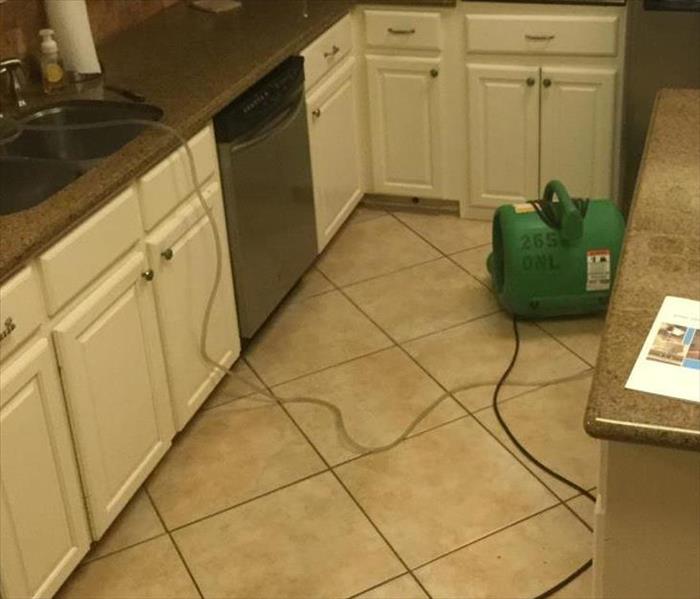 A refrigerator supply line busted causing water damage throughout the kitchen.
A refrigerator supply line busted causing water damage throughout the kitchen.
Did you know that SERVPRO has service response guidelines for water damage? We follow the guidelines 1-4-8. Our SERVPRO team realizes how important it is to be “Faster to Any Size Disaster.” Our team also emphasizes the importance of communication.
- Within ONE hour from notice of a loss, SERVPRO of Beaumont will contact you to arrange for services.
- Within FOUR hours of a loss notification, SERVPRO of Beaumont will be on-site to start mitigation services (if necessary).
- Within EIGHT hours, a verbal briefing of the scope will be communicated to you by our SERVPRO staff.
Do you have water damage in your home or business? Contact the SERVPRO of Beaumont today— (409) 212-1977!
**Exceptions may apply under certain conditions, such as a local catastrophic event or storm situation**
Water Damage from Contaminated Water
6/8/2020 (Permalink)
Contaminated water also described as “black water” and is grossly unsanitary. Black water can also be described as Category 3 water in water restoration terms. This category includes water sources from sewage, seawater, rising water from rivers or streams, ground surface water or standing water.
If you experience water damage from contaminated water, here are some Dos and Don’ts:
Do:
- Avoid all contact with sewage and items contaminated by sewage
- Wash your hands thoroughly after contact with contaminated items.
Don’t:
- Spread contaminated water by walking unnecessarily on damaged or wet areas.
- Turn on the HVAC system if there is a possibility of spreading contaminated air
- Use household fans to dry the structure and spread contaminates
- Use products for personal hygiene and cleanliness if exposed to the contaminated areas
Have more questions about contaminated water, contact the SERVPRO of Beaumont today!
2020 Hurricane Season
6/2/2020 (Permalink)
The National Oceanic and Atmospheric Administration (NOAA) is expecting an above-normal 2020 Atlantic hurricane season. The outlook is predicting a 60% change of an above-normal season. The Atlantic hurricane season runs from June 1st through November 30th.
The NOAA states that the combination of several climate factors is driving the strong likelihood for an above-normal activity in the Atlantic this year. The El Nino Southern Oscillation (ENSO) conditions are expected to either remain neutral or to trend toward La Nina, which means there will not be an El Nino present to suppress hurricane activity. Also, warmer-than-average sea surface temperature in the tropical Atlantic Ocean and Caribbean Sea, coupled with reduced vertical wind shear, weaker tropical Atlantic trade winds and an enhanced west African monsoon all increase the likelihood for an above-normal hurricane season.
During the 2020 hurricane season, the NOAA and the U.S. Navy will deploy a fleet of autonomous diving hurricane gliders to observe conditions in the tropical Atlantic Ocean and Caribbean Sea in areas where hurricanes have historically traveled and intensified.
Source:
https://www.noaa.gov/media-release/busy-atlantic-hurricane-season-predicted-for-2020
When Water Damage Strikes
3/27/2020 (Permalink)
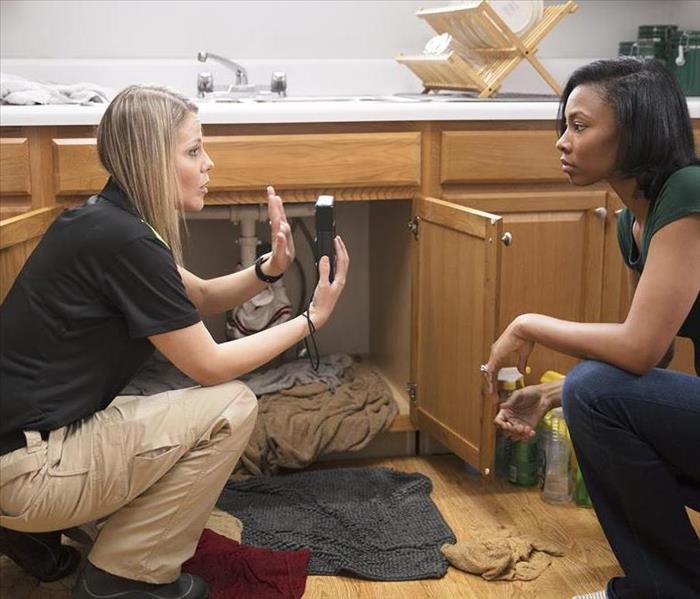 SERVPRO of Beaumont/Orange/Nederland/Lumberton can explain the steps needed to take in the event of a water loss.
SERVPRO of Beaumont/Orange/Nederland/Lumberton can explain the steps needed to take in the event of a water loss.
The first 24 hours following a water loss are the most important in preventing secondary or permanent damage. Within four hours of receiving a loss notification, SERVPRO of Beaumont/Orange/Nederland/Lumberton will be on site to help ensure a water damage is handled by completing the following steps.
Inspection
SERVPRO professionals will inspect affected areas to determine the extent of water damage and will review the inspection with you to answer any questions before beginning the work.
Emergency Services
Our SERVPRO professionals will take steps to help protect your home or business, as well as personal property and other contents, from further damage by extracting the excess water and preparing the area for drying. They will explain the needed emergency services to you step-by-step.
Monitoring
To help ensure your home or business and belongings are dried to appropriate industry standards, one of our SERVPRO professionals will monitor the drying process. The updates will be consistently communicated with you.
Restoration Services
The SERVPRO of Beaumont/Orange/Nederland/Lumberton can repair structural materials, reinstall carpets, and clean affected areas of your property and contents. A final walk-through of the jobsite will be conducted with you to help ensure the property was returned to its preloss condition.
Emergency Water Damage Tips
2/20/2020 (Permalink)
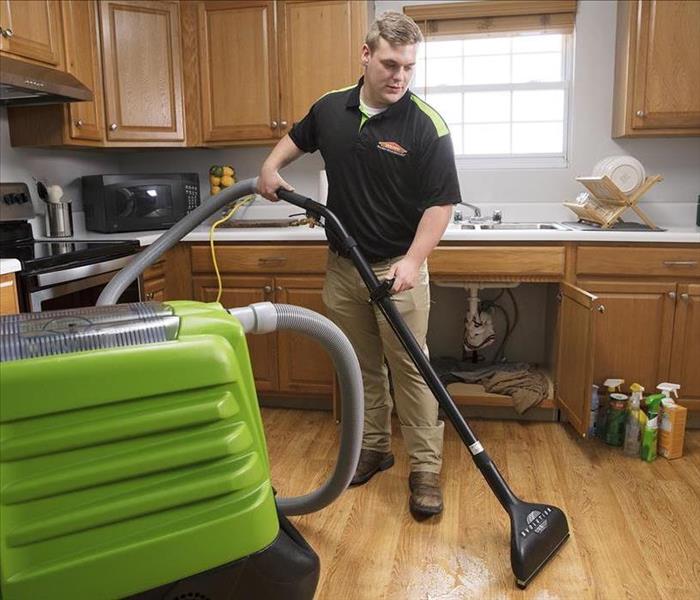 Emergency water extraction from damaged kitchen.
Emergency water extraction from damaged kitchen.
- Shut off the water source, if possible or contact a qualified professional to stop the water source.
- Turn-off circuit breakers for wet areas of the building when access to the power distribution panel is safe from electrical shock.
- Remove as much excess water as possible by mopping and blotting
- Place aluminum foil or word blocks between furniture legs and wet carpeting
- Move any paintings, art objects, computers, documents and other sensitive valuables to a dry place.
- Do not enter affected areas if electrical outlets, switches, circuit breakers, or electrical equipment are exposed to water. Always avoid electrical shock hazards.
- Do not use your household vacuum to remove water! This could cause electrical shock and cause damage to the vacuum.
- Do not turn on ceiling fixtures if the ceiling is wet or enter the room where ceilings are sagging from retained water.
Have questions regarding water damage? Contact the SERVPRO of Beaumont/Orange/Nederland/Lumberton today!
Understanding Water Types
6/25/2019 (Permalink)
When your home or business suffers a water damage, understanding what type of water you are dealing with is critical to ensuring proper cleanup.
There are three types of water. Clean water is water from a broken pipe, or other water source; rainwater is also considered clean. The term gray water is used to classify slightly contaminated water. Clean water becomes gray water when it is left untreated allowing bacteria and other contaminant to begin growing, making the water hazardous. Black water is highly contaminated and filled with fungi, bacteria, chemicals and more. Black water is typically caused by sewage damage, flooding or any type of natural disaster. Black water should always be handled by trained professionals.
If you have water damage in your home, contact the SERVPRO of Beaumont/Orange/Nederland/Lumberton—(409) 212-1977!
Water Damage
5/31/2019 (Permalink)
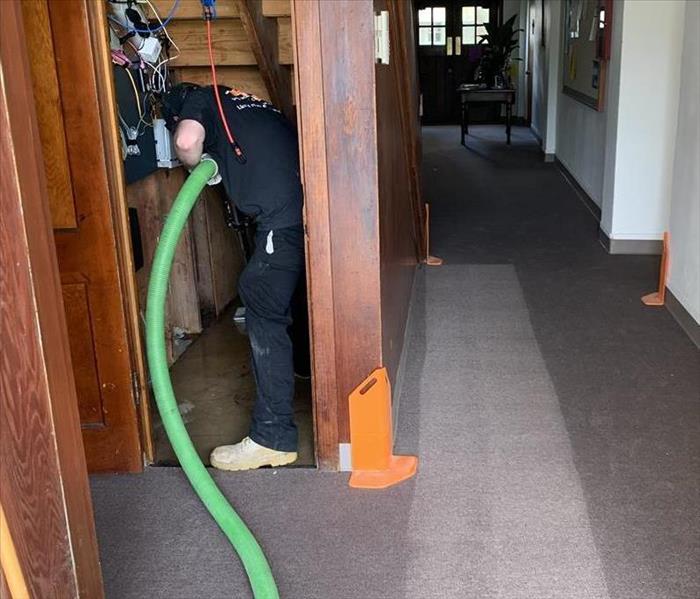 Emergency water extraction after a busted pipe.
Emergency water extraction after a busted pipe.
Water damage can happen at any time. The SERVPRO of Beaumont handles water damage every day and realizes that prompt action is key in the event of any disaster. Our SERVPRO technicians are trained in the proper techniques to inspect a home or business and assess the damage after a disaster. We use technology that is designed to determine the amount of moisture in an affected area, iPads to document the findings, and the proper placement of air movers and dehumidifiers to ensure proper drying. Our SERVPRO Professionals understand water damage and have the proper training and equipment to take care of all of your water damage needs 24/7, 365 days a year!
Have questions about water damage? Contact the SERVPRO of Beaumont today—(409) 212-1977!
SERVPRO of Beaumont is Faster to ANY Disaster
5/30/2019 (Permalink)
Flooding and water emergencies don’t have to wait for regular business hours and neither do we. SERVPRO of Beaumont provides emergency cleaning and restoration services 24 hours a day, 7 days a week—including all holidays.
Faster to Any Size Disaster
Flooding and water damage is very invasive. Water quickly spreads throughout your home and gets absorbed into floors, walls, furniture and more. SERVPRO of Beaumont arrives quickly and starts the water extraction process almost immediately. This immediate response helps to minimize the damage and the cleaning and restoration costs.
Need Emergency Service? Call us 24/7—(409) 212-1977
Water Damage Timeline
Within Minutes:
- Water quickly spreads throughout your property, saturating everything in its path.
- Water is absorbed into walls, floors, upholstery and belongings.
- Furniture finishes may bleed, causing permanent staining on carpets.
- Photographs, books, and other paper goods start to swell and warp.
Hours 1-24:
- Drywall begins to swell and break down.
- Metal surfaces begin to tarnish.
- Furniture begins to swell and crack.
- Dyes and inks from cloth and paper goods spread and stain.
- A musty odor appears.
48 Hours to 1 Week:
- Mold and mildew may grow and spread.
- Doors, windows, and studs swell and warp.
- Metal begins to rust and corrode.
- Furniture warps and shows signs of mold.
- Paint begins to blister.
- Wood flooring swells and warps.
- Serious biohazard contamination is possible.
More than 1 Week:
- Restoration time and cost increases dramatically; replacing contaminated materials and structure rebuilding may be extensive.
- Structural safety, mold growth, and biohazard contaminants pose serious risks to occupants.
Proper Drying and Dehumidifcation
5/20/2019 (Permalink)
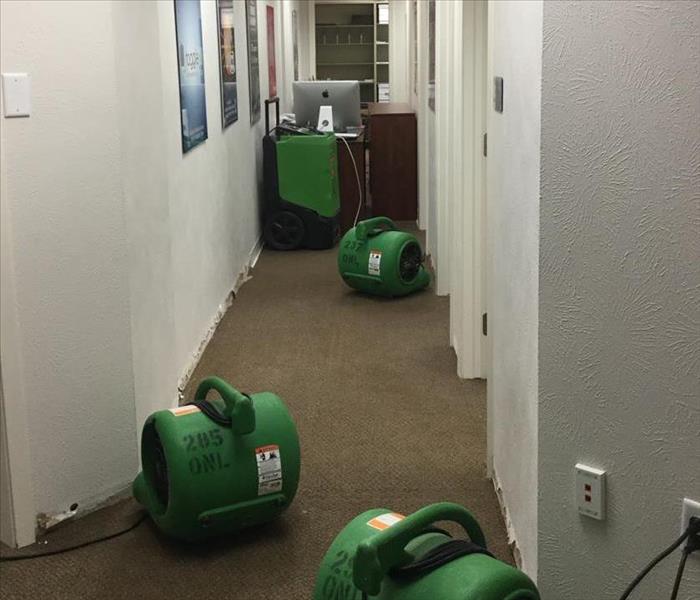 Drying after water damage in a commercial building.
Drying after water damage in a commercial building.
The first step to any water damage is removing the standing water. Even though your floors and walls may look dry at first glance; they are still wet to the touch. Most building materials, like drywall and wood, are porous and will retain significant water. The retained water will cause these materials to warp, swell, or break down and can also cause damage.
SERVPRO of Beaumont will manipulate the temperature and relative humidity to remove the remaining moisture. We use specialized equipment, including industrial air movers and dehumidifiers, to remove water retained by building materials and other hard-to-access moisture. Our SERVPRO professionals carefully monitor the progress using moisture meters until the materials return to acceptable drying goals.
Our SERVPRO of Beaumont professionals are trained and certified according to the Institute of Inspection Cleaning and Restoration Certification (IICRC) guidelines specifically in Water Restoration. SERVPRO also encorporates its own Employee Certification Trainings in Water Damage as well. Our SERVPRO team members are highly trained and ultimately Here to Help!
Water Damage Do's & Don'ts
3/27/2019 (Permalink)
Many of us do not know the first steps to take in the event of water damage in our homes. SERVPRO has over 40 years of leadership and training in cleanup and restoration services. SERVPRO has put together a few Do’s and Don’ts to help in the event of water damage in your home.
Water Damage from Clean Water
DO:
- Shut off the source of the water as quickly as possible.
- Turn off any circuit breakers for wet areas of the building when access to the breaker box is safe from electrical shock.
- Remove as much excess water as possible by mopping & blotting.
- Wipe excess water from wood furniture after removing lamps and tabletop items.
- Place aluminum foil or wood blocks between furniture legs and wet carpet.
- Remove any documents, computers and other materials that are valuable or sensitive to moisture.
DON’T:
- Enter rooms with standing water where electrical shock hazards are at risk.
- Enter affected areas if electrical outlets, switches or circuit breakers are exposed to water/
- Leave books, newspapers. Magazines or other colored items on wet carpets or floors to cause staining.
- Leave oriental rugs or other colored rugs on wet wall-to-wall carpets to cause staining.
- Use your household vacuum cleaner to remove excess water. This could cause electrical shock or damage the vacuum cleaner.
- Use TVs or other appliances while standing on wet carpets or floors.
- Turn on ceiling fixtures if the ceilings are wet or enter rooms where ceilings are sagging from retained water.
Tips to Minimize Water Damage
3/1/2019 (Permalink)
In the event that your home or business has a water loss, here are some steps to help minimize damage.
- Shut off the water source if possible or contact a qualified party to stop the water source.
- Turn off circuit breakers for wet areas of the building when access to the power distribution panel is safe from electrical shock.
- Remove as much excess water as possible by mopping and blotting.
- Place aluminum foil or wood blocks between furniture legs and wet carpet.
- Move any paintings, art objects, computers, documents, and other sensitive valuables to a dry place.
- Don’t enter affected areas if electrical outlets, switches, circuit breakers, or electrical equipment are exposed to water. Always avoid shock hazards.
- Don’t use your household vacuum cleaning to remove water; this could cause electrical shock or damage the vacuum cleaner.
- Don’t turn on ceiling fixtures if ceiling is wet or enter rooms where ceilings are sagging from retained water.
Determining the Category of Water Damage
5/25/2018 (Permalink)
IICRC S500 Standard Reference Guide for Professional Water Damage Restoration defines three categories of water. Category refers to the type of water affecting the structure.
A Category I loss is where water originates from a sanitary water source and does not pose substantial risk from dermal, ingestions or inhalation exposure. A Category II loss is when water contains a significant contamination and has the potential to cause discomfort or sickness if contacted or consumed by humans. Category II water can contain potentially unsafe levels of microorganisms or nutrients for microorganisms. Examples of Category II are: Discharge from dishwashers or washing machines, overflows from washing machines, overflows from toilet bowls on the room side of the trap with some urine. Category III water is grossly contaminated and can contain pathogenic, toxigenic or other harmful agents and can cause significant adverse reactions to humans if contacted or consumed. Examples of Category III water are: Sewage, Flood water, and other contaminated water entering or affecting the indoor environment, such as wind-driven rain from hurricanes, tropical storms or other weather-related events.
Have questions about water damage? Contact the SERVPRO of Beaumont today at (409) 212-1977.
Drying and Dehumidification
5/17/2018 (Permalink)
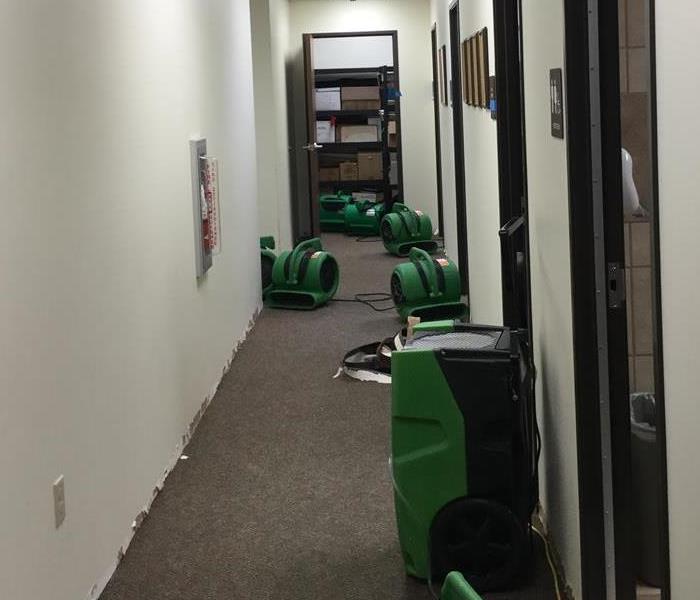 SERVPRO helping properly dry a commercial building.
SERVPRO helping properly dry a commercial building.
The first step to any water damage is removing the standing water. Even though your floors and walls may look dry at first glance; they are still wet to the touch. Most building materials, like drywall and wood, are porous and will retain significant water. The retained water will cause these materials to warp, swell, or break down and can also cause damage.
SERVPRO of Beaumont will manipulate the temperature and relative humidity to remove the remaining moisture. We use specialized equipment, including industrial air movers and dehumidifiers, to remove water retained by building materials and other hard-to-access moisture. Our SERVPRO professionals carefully monitor the progress using moisture meters until the materials return to acceptable drying goals.
Our SERVPRO of Beaumont professionals are trained and certified according to the Institute of Inspection Cleaning and Restoration Certification (IICRC) guidelines specifically in Water Restoration. SERVPRO also encorporates its own Employee Certification Trainings in Water Damage as well. Our SERVPRO team members are highly trained and ultimately Here to Help!
Faster to Any Disaster
3/16/2018 (Permalink)
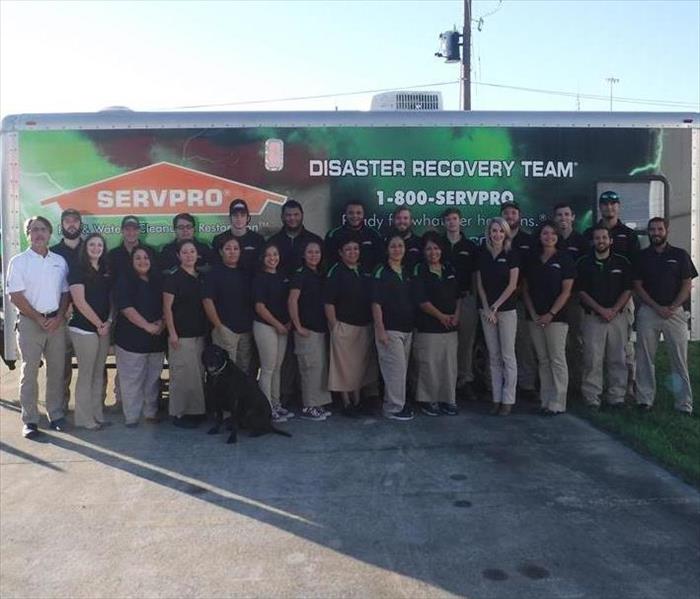 SERVPRO of Beaumont provides 24 hour fire and water damage restoration services.
SERVPRO of Beaumont provides 24 hour fire and water damage restoration services.
Flooding and water emergencies don’t have to wait for regular business hours and neither do we. SERVPRO of Beaumont provides emergency cleaning and restoration services 24 hours a day, 7 days a week—including all holidays.
Faster to Any Size Disaster
Flooding and water damage is very invasive. Water quickly spreads throughout your home and gets absorbed into floors, walls, furniture and more. SERVPRO of Beaumont arrives quickly and starts the water extraction process almost immediately. This immediate response helps to minimize the damage and the cleaning and restoration costs.
Need Emergency Service? Call us 24/7—(409) 212-1977
Water Damage Timeline
Within Minutes:
- Water quickly spreads throughout your property, saturating everything in its path.
- Water is absorbed into walls, floors, upholstery and belongings.
- Furniture finishes may bleed, causing permanent staining on carpets.
- Photographs, books, and other paper goods start to swell and warp.
Hours 1-24:
- Drywall begins to swell and break down.
- Metal surfaces begin to tarnish.
- Furniture begins to swell and crack.
- Dyes and inks from cloth and paper goods spread and stain.
- A musty odor appears.
48 Hours to 1 Week:
- Mold and mildew may grow and spread.
- Doors, windows, and studs swell and warp.
- Metal begins to rust and corrode.
- Furniture warps and shows signs of mold.
- Paint begins to blister.
- Wood flooring swells and warps.
- Serious biohazard contamination is possible.
More than 1 Week:
- Restoration time and cost increases dramatically; replacing contaminated materials and structure rebuilding may be extensive.
- Structural safety, mold growth, and biohazard contaminants pose serious risks to occupants.
What To Do Until Help Arrives
3/7/2018 (Permalink)
Many of us do not know the first steps to take in the event of water damage in our homes. SERVPRO has over 40 years of leadership and training in cleanup and restoration services. SERVPRO has put together a few Do’s and Don’ts to help in the event of water damage in your home.
Water Damage from Clean Water
DO:
- Shut off the source of the water as quickly as possible.
- Turn off any circuit breakers for wet areas of the building when access to the breaker box is safe from electrical shock.
- Remove as much excess water as possible by mopping & blotting.
- Wipe excess water from wood furniture after removing lamps and tabletop items.
- Place aluminum foil or wood blocks between furniture legs and wet carpet.
- Remove any documents, computers and other materials that are valuable or sensitive to moisture.
DON’T:
- Enter rooms with standing water where electrical shock hazards are at risk.
- Enter affected areas if electrical outlets, switches or circuit breakers are exposed to water/
- Leave books, newspapers. Magazines or other colored items on wet carpets or floors to cause staining.
- Leave oriental rugs or other colored rugs on wet wall-to-wall carpets to cause staining.
- Use your household vacuum cleaner to remove excess water. This could cause electrical shock or damage the vacuum cleaner.
- Use TVs or other appliances while standing on wet carpets or floors.
- Turn on ceiling fixtures if the ceilings are wet or enter rooms where ceilings are sagging from retained water.
Preventing Water Damage
3/2/2018 (Permalink)
A small amount of water soaking into your floors, walls or cabinets is all it takes to cause damage in your home or business. A study of closed water damage insurance claims identified plumbing pipes and drain systems as the leading cause of interior water damage. The following tips can help you minimize the risk in your home or business.
- Proper Maintenance—majority of insurance claims were caused by corroded, rusty, or frozen pipes. Maintaining these in your home or business can help prevent any future damage.
- Look for an increase in your monthly water bill—pipes with leaks can cause your water to bill to increase.
- Rust stains, moisture in the walls or on the floor are all potential indicators of plumbing issues.
- If you are on a sewer system or you are located below street level—contact a plumbing professional to install a backflow prevention into your sewer system.
- Make sure to plant trees away from lateral drain lines to prevent roots from damaging pipes.
- NEVER pour grease down the drain.
Source: www.disastersafety.org
The Science Behind Drying
2/22/2018 (Permalink)
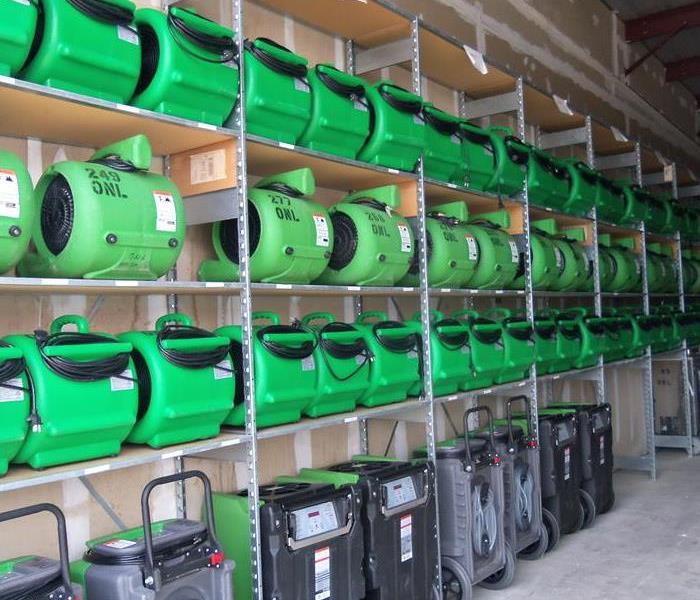 Warehouse full of state of the art drying equipment,
Warehouse full of state of the art drying equipment,
Most people do not know that there is a process behind the science of drying. One of SERVPRO’s goals is to help restore a water damaged structure back to its preloss condition. The knowledge of psychrometrics is a vital part of the restoration process. Here at SERVPRO, we understand the first reaction during any water loss is to grab a towel and to try and clean the mess up. SERVPRO of Beaumont is trained in the science of drying and follow strict industry guidelines to help lower the chances of any secondary damage to your home. Allowing your home to dry on your own is possible. However, drying naturally make take too long and the moisture may can cause more damage to areas in your home. Our team is trained to help speed up the natural drying process, including equipment to help dry hardwood floors, difficult to reach areas, and spaces inside walls. Our team uses state of the art monitoring equipment and a proven scientific process to help speed up the drying process. This process helps our customers get back to normal in no time!
Understanding Water Types
3/9/2017 (Permalink)
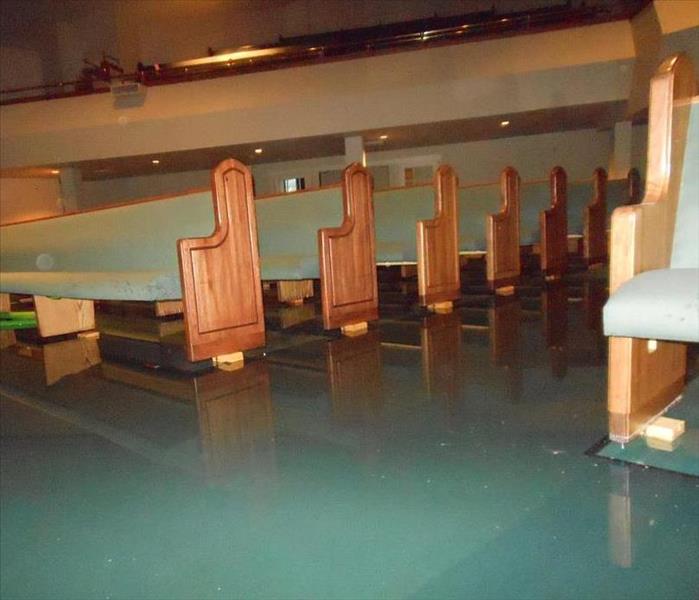 This is a picture of a commercial water loss that occurred at a church. Notice the blocking of the pews.
This is a picture of a commercial water loss that occurred at a church. Notice the blocking of the pews.
Understanding Water Types
When your home or business suffers a water damage, understanding what type of water you are dealing with is critical to ensuring proper cleanup.
There are three types of water. Clean water is water from a broken pipe, or other water source; rainwater is also considered clean. The term gray water is used to classify slightly contaminated water. Clean water becomes gray water when it is left untreated allowing bacteria and other contaminants to begin growing, making the water hazardous. Black water is highly contaminated and filled with fungi, bacteria, chemicals and more. Black water is typically caused by sewage damage, flooding or any type of natural disaster. Black water should always be handled by trained professionals.
Consider taking the following precautions to help minimize damage or prevent further damage while waiting for help to arrive.
Damage from Clean Water
- Shut off the water source if possible or contact a qualified professional to do so.
- Turn off circuit breakers for wet areas of the building if access to the power distribution panel is safe from potential electrical shock. Do not enter rooms with standing water, as electrical shock hazards may exist.
- Remove as much excess water as possible by mopping and blotting. Wipe excess water from wood furniture after removing lamps and tabletop items.
- Remove and prop up wet upholstery cushions to allow more even drying.
- Move any paintings, are objects, computers, documents and other valuable items that may be sensitive to moisture to a safe place.
- Do not leave books, newspapers, magazines or other colored items on wet carpets or floors as they may cause staining.
- Do not use your household vacuum cleaner to remove water as there is potential for electrical shock or causing damage to the vacuum cleaner.
- Do not turn on ceiling fixtures if ceiling is wet; do not enter rooms where ceilings are sagging from retained water.
-
Damage from Contaminated Water
- Avoid all contact with sewage and items contaminated by sewage. Wash your hands thoroughly if you come in contact with contaminated items.
- Do not walk through contaminated areas, as you could spread damage to unaffected areas.
- Do not turn on the HVAC system if there is a possibility of spreading contaminated air.
- Do not use household fans to dry the structure, air flow could spread contaminants.
- Discard any food and/or products for personal hygiene and cleanliness if exposed to the contaminated areas.SERVPRO’s network of more than 1,700 Franchises is ready to help in the event a fire, water, or mold loss occurs
- Call on a restoration system serving insurance companies and their insureds, as well as thousands of commercial property owners in North America. Don’t leave your property to chance.




 24/7 Emergency Service
24/7 Emergency Service




